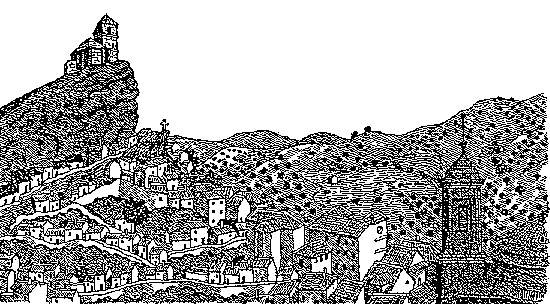MAYONNAISE OR MAHONESA?By Lawrence BohmeOne summer some ten years ago, several people became ill after eating at a certain restaurant near Valencia; it was discovered that the raw eggs that had been used in the mayonnaise were spoiled due to the intense heat. Ever since this outbreak of "salmonella", Spain's restaurants - many of which used to pride themselves on their home-made mayonnaise - have been forbidden to serve anything but the small foil envelopes of tastless goo which you get on in-flight food trays. In the outbreak of indignation which followed, a letter to the editor published in El Pais maintained that mayonnaise (in current Spanish, mayonesa) was in fact "salsa mahonesa" and had been invented in the city of Mahon, Menorca. Therefore, the author protested, outlawing the cottage industry production thereof - salmonella notwithstanding - constituted one more outrage in the long list of attempts to replace national culture with the soulless, sanitized American version. As a lover (and maker, as you will see further on) of real, exciting mayonnaise, I agree that the very slight risk of catching salmonella is insufficient cause for preventing foreign tourists from getting a taste of "the real thing" when they eat at restaurants in Spain. But the author of the letter, in his nationalistic fervour, did not tell the whole story: mayonnaise was invented in Spain, but, as luck would have it, by a Frenchman, not by a Spaniard. It all happened back in the early 18th century, when Louis XIV dispatched his favourite general, the Duc de Richelieu, to Menorca to root out some troublesome Englishmen who were holed up in the fort overlooking the harbour of Mahon. During the long siege, the Duke's cook found himself hard pressed to keep his master - accustomed to the fabulous banquets of Versailles - entertained at table. He wanted to make an interesting sauce to liven things up, but all he could find on the island was eggs and olive oil... You can imagine the rest - he started beating and beating, and with the help of a bit of vinagre produced what was christened on the spot as "la sauce mahonnaise", which we could (but won't) translate as Mahonian Sauce.* Like many other such terms, "mahonnaise" played what I call the game of "linguistic ping-pong". The French soon Frenchified the word by changing the h for a y, and once the invention had been consecrated in Versailles it entered mainland Spain as "mayonesa". Some purists now insist on using "mahonesa" to stress its Iberian origin, but the rank and file, oblivious to everything but their enjoyment of the sauce, say "mayonesa". (It's a bit like the barbecue: the term was coined by French buccaneers in the Caribbean, who roasted a whole goat by driving a wooden spit from the "beard" to the "tail", hence "barbe a queue"; the Americans eventually adapted the practice as a mainstay of their national diet and sent it back to 20th century France where it was avidly espoused, like everything else "made in Californie" as "le barbecue". Perhaps it would not have caught on so well if it had been called by its original name - can you imagine Maurice saying to Nicole, "Cherie, how about a "beard to tail" in the garden tonight?".) Whenever possible, I invite the guests who stay in my holiday cottages here in Montefrio out to my "cortijo" for a drink and tapas, and - again, whenever possible - this includes a platter of prawns and a bowl of my own mayonnaise to dip them in. All those who are not allergic to garlic go wild over it, and it also has the virtue of being very easy to make, so here's the recipe. As you might have guessed, I got it in France (from my former French wife, to be exact) and then beefed it up with this and that until I arrived at MAHONESA DE MONTEFRIO
Crack a WHOLE raw egg into a blender; the egg MUST be room temperature or the oil won't emulsify. Add half a cup of olive oil (if you can get virgin unrefined olive oil, mejor). A good squirt of vinagre (and/or lemon juice). Salt, pepper, a teaspoon of sugar, a generous gob of mustard, a big dash of curry powder and several cloves of garlic chopped in large pieces. Turn on the machine; as soon as the sauce begins to thicken, add another half cup or so of oil until it gets so thick that it ceases to mix. Taste and add salt, sugar, mustard or vinagre if necessary, until you get the right tangy sweet-and-sour taste. Mahonesa de Montefrio is like the flamenco of our local gypsies - if it don't make your hair stand on end, it ain't worth a "duro"! Serving suggestions: you can only find freshly-boiled prawns in the fish market in Granada, so I sometimes serve it to accompany cold sliced meats (leftover roast chicken, lamb or pork) and raw celery, cucumber, tomato... As for the risk of salmonella, it only affects the eggs after they have been broken and left out of the fridge too long, in the summer heat.*(Bibliography: Nancy Mitford's classic biography "Madame Pompadour") Favorite Spanish Recipes | Mas recetas de Espaņa | More Spanish Stories |
